Aim for the narrowest possible row spacing
Author: Peter Newman - AHRI | Date: 07 May 2014
Peter Newman, Leader of communications, AHRI
Key messages
The most cost effective way to implement crop competition with weeds may be through options such as narrow crop row spacing, crop row orientation and cultivar rather than simply increasing the seed rate.
This trial shows, like many others in the past, that wheat sown at narrow row spacing yields more than wheat sown at wide row spacing.
Wheat sown at the low seeding rate of 60 kg/ha was slightly higher yielding than wheat sown at higher seeding rates.
We compared single row sowing with ribbon sowing and paired row sowing in this trial. There was little yield difference between the three seeding systems. The paired row sowing treatment did not achieve perfect paired rows, probably due to the narrow press-wheel.
Wheat sown at narrow row spacing has higher seeding efficiency (i.e. the percent of seed sown that emerges) than wheat sown at wide row spacing.
Narrow row spacing = more crop, less weeds.
Aims
To determine if wheat sown at wide row spacing with paired row or ribbon sowing can achieve a similar yield to wheat sown with single row sowing at narrow row spacing.
To determine the most efficient use of crop seed to achieve optimum crop density with the minimum seed rate.
Method
Mace wheat (35.75 mg seed size) sown on 30 & 31 May 2013 at Peter Horwood’s property. Yellow sandplain soil 7 km west of Mingenew. Sown using DAFWA plot seeder, 80 kg/ha Agras drilled at seeding. Factorial trial design. Three row spacings (15, 22 and 30 cm), by three seed rates (60, 90 and 120 kg/ha), by three seeding systems (single row sowing – standard super seeder point, Paired row sowing – Stiletto seeding boot creating two crop rows 75 mm apart (perfect paired rows were not achieved in this trial likely due to narrow press-wheel), and Ribbon sowing – Stiletto boot modified to ribbon sow approximately a 50 mm wide ribbon of seed) by 4 replications. Site was sprayed with Sakura 118 g/ha + Logran 35 g/ha + glyphosate 2 L/ha on 28 May by grower. Excellent soil moisture at seeding followed by six week dry spell during which time approximately 10mm of rain fell. Excellent spring rains. Paddock rotation was lupin in 2012. Paddock sprayed for broadleaf weeds and nitrogen fertiliser applied by grower (Flexin N 40 L/ha). Plant establishment counts conducted on 25 June 2013 by DAFWA staff. 4 counts of 2m of crop row per plot. Wheat head counts conducted on 22 October 2013 by counting wheat heads per 0.7m of crop row. Harvested with plot harvester 6 November 2013. Centre rows of each plot were harvested to remove the edge effect. Harvest width of 90 cm was used for the 15 cm (6 rows harvested) and 30 cm (3 rows harvested). For the 22 cm row spacing treatment 5 rows were harvested giving a harvest width of 110 cm. Grain quality assessed at DAFWA Geraldton laboratory.
Results
Wheat yield
Yield response (Figure 1) to row spacing of 247 kg/ha was achieved when comparing 15 cm row spacing with 30 cm row spacing (lsd 162 kg/ha). This equates to 16.5 kg/cm/ha.
The 22cm row spacing was 151 kg/ha lower yielding than 30cm row spacing although this result was not significant. There was no visible reason for this during the growing season.
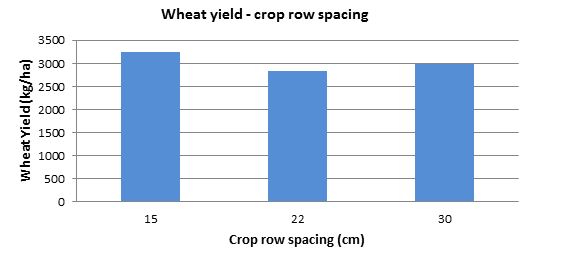
Figure 1 Wheat yield (kg/ha) compared between three crop row spacings (15, 22 and 30 cm) averaged across three seeding systems.
The low wheat seeding rate of 60 kg/ha achieved slightly higher yield than the higher seeding rates (lsd 133.4 kg/ha) (Figure 2).
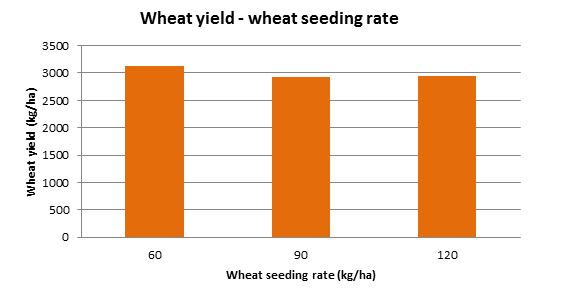
Figure 2 Wheat yield (kg/ha) at various seeding rates (averaged across all seeding systems)
There were minor differences in wheat yield between seeding systems with a slight yield advantage to single row sowing when averaged across all seeding rates and row spacings (Figure 3).
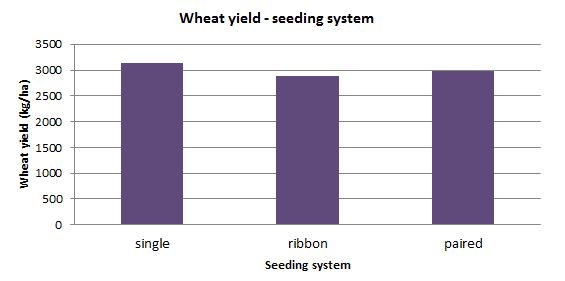
Figure 3 Wheat yield (kg/ha) compared between three seeding systems; single row sowing, ribbon sowing & paired row sowing (averaged across all seeding rates and row spacing)
Wheat establishment – ribbon sowing
Higher wheat plant density was achieved with higher seeding rates (Figure 4). Wheat plant density also responded to row spacing where narrow row spacing achieved higher plant densities.
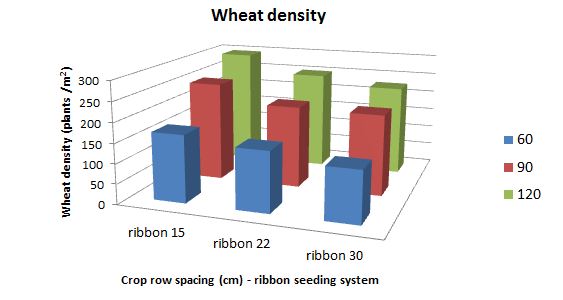
Figure 4 Wheat density (plants /m2) of ribbon seeding system at three crop row spacings across three seeding rates of 60, 90 & 120 kg/ha.
Seeding efficiency – ribbon sowing
Seeding efficiency is a measure of what percentage of the seed that was sown actually emerges. The number of seeds sown was calculated by knowing the seed size of the Mace wheat used in the trial. The seed size was 35.75 mg/seed.
The highest seeding efficiency was achieved with lower seeding rates and narrow row spacing (Figure 5).

Figure 5 Wheat seeding efficiency (i.e. % of seeds sown that emerged) of ribbon seeding system at three crop row spacings across three seeding rates of 60, 90 & 120 kg/ha.
Wheat yield – ribbon sowing
Despite large differences in wheat head density between treatments there were only minor differences in wheat yield of the ribbon sown treatments (Figure 6). The main yield difference that was observed was that the 15cm row spacing had higher yield than 22 and 30 cm row spacing treatments for the ribbon seeding system.
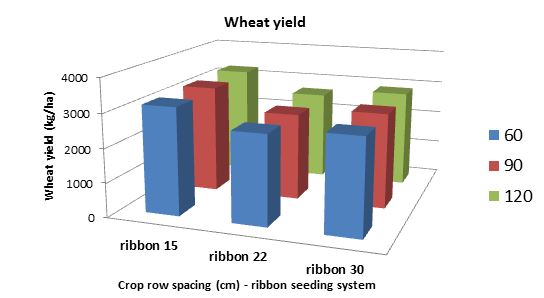
Figure 6 Wheat yield (kg/ha) of ribbon seeding system at three crop row spacings across three seeding rates of 60, 90 & 120 kg/ha.
Grain Quality
Only minor differences in grain quality were observed between treatments. There were no differences in screenings levels between seeding rates and only very minor differences in protein and hectolitre weight. There were very small (0.3%) differences in protein between treatments which appeared to reflect yield (i.e. higher yielding treatments had lower protein and vice versa).
Conclusion
Summary of results
- Narrow row spacing yielded more than wide row spacing (figures 1 & 6)
- Low seeding rate yielded more than higher seeding rates (figure 2)
- There was little or no difference in yield between seeding systems (figure 3)
- The highest seeding efficiency was achieved with low seeding rate combined with narrow row spacing. (figures 4 & 5)
Row spacing
The row spacing yield response of 16.5 kg grain / cm of row spacing / ha was directly in line with previous row spacing research. Brendan Scott et al. (2013) reviewed 89 row spacing trials from around Australia showing conclusively that narrow row spacing of wheat yields more than wide row spacing. The yield response to row spacing changes with yield potential. Higher yielding wheat crops have more to lose from wide row spacing than lower yielding crops. For wheat crops of 3 t/ha yield potential, the average of 89 trials shows that a yield response to row spacing is typically 15 kg/cm/ha. For example, reducing row spacing by 10 cm will give a yield improvement of 150 kg/ha for a wheat crop with 3 t/ha yield potential.
The 22 cm row spacing treatment consistently under performed in this trial for no apparent reason. Logic and previous research data would have us expect that the yield of 22 cm row spacing should be roughly half way between the yield of the 15 cm and 30 cm row spacings, however, this did not occur. One possible explanation is the harvest technique. Only the centre rows of each plot were harvested to remove the edge effect. Consequently, a harvest width of 90 cm was used for the 15 cm and 30 cm treatments and a harvest width of 110cm (5 rows) was used for the 22 cm row spacing treatment. Mathematically this all adds up, however, it is possible that the adjusting of the harvester front may have caused a bias that disadvantaged the 22 cm treatments.
Seeding systems
The main objective of this trial was to attempt to answer the question, ‘Can paired row sowing at wide row spacing achieve similar yield to single row sowing at a narrower row spacing?’ Unfortunately we were not able to answer this question due to yield variation and consequently there was little yield difference between the three seeding systems used. The paired row sowing boot used in the trial (Stiletto boot) aims to create a pair of crop rows 75 mm apart. Given that previous research has shown that we can expect a 15 kg/cm/ha yield response to row spacing (3 t/ha wheat yield potential), theory would tell us that this paired row sowing should increase wheat yield by 112.5 kg/ha. However, we did not consistently observe this response in this trial.
Seeding rate
The lowest seeding rate of 60 kg/ha achieved an average wheat plant density of 150 plants /m2 (Ribbon sowing; table 2). The rule of thumb for matching plant density to yield potential in Western Australia is 50 wheat plants per tonne of yield potential in a weed free situation. Consequently, the 60 kg/ha seeding rate achieved the optimal wheat plant density for the yield potential in this trial, suggesting that 150 plants / m2 was optimum at this site.
Seeding efficiency
The most efficient use of wheat seed is to sow it at narrow row spacing, giving each seed more room to germinate and emerge. Everything in farming these days is about efficiency. In this trial, the highest seeding efficiency was achieved with narrow row spacing in combination with low seeding rates. Increasing the wheat seeding rate did increase the wheat plant density, however, the seeding efficiency was compromised. For the ribbon sowing treatment sown at 60 or 90 kg/ha, 99 to 100% of this seed emerged. This dropped to 76 to 80% of seed emerging for the 30cm row spacing. This response was consistent for the other seeding systems.
Crop competition with weeds
Wheat seeding rate and row spacing is all about maximising crop yield and minimising weed seed set.
The crop row spacing review paper by Brendan Scott et. al. clearly demonstrates that growers should aim for the lowest crop row spacing that is practical and achievable to maximise wheat yield. Glen Riethmuller (DAFWA) demonstrated in 2005 that reducing crop row spacing from 27 cm to 18 cm (9 cm reduction) resulted in a 38% reduction in ryegrass seed set. Other data by David Minkey (WANTFA) and Abul Hashem (DAFWA) showed similar results (DAFWA trials). All growers and agronomists have observed how well weeds grow where there is a blocked seeding row (creating very wide row spacing). This all adds up to narrow crop row spacing resulting in more crop and fewer weeds.
We also know that increasing the wheat seeding rate results in higher crop densities which also reduces weed seed set through increased crop competition. However, this trial shows that at wide row spacing, seeding efficiency is compromised. Therefore, I propose that it is more efficient and cost effective to increase crop competition through narrow row spacing in combination with optimal plant density than simply increasing the seeding rate for current crop row spacing.
Key words
Wheat, row spacing, seeding rate, paired row sowing, ribbon sowing
Acknowledgments
A huge thank you to the DAFWA trials team Steve Cosh, Larry Prosser, Murray Blythe and Greg Brown, I put them through hell to seed this trial. Big thanks to Peter and Belinda Horwood for making a site available at very short notice and to GRDC for funding, also at very short notice.
GRDC Project No.:
Paper reviewed by: Peter Elliot-Lockhart, Planfarm Agronomist
Was this page helpful?
YOUR FEEDBACK
